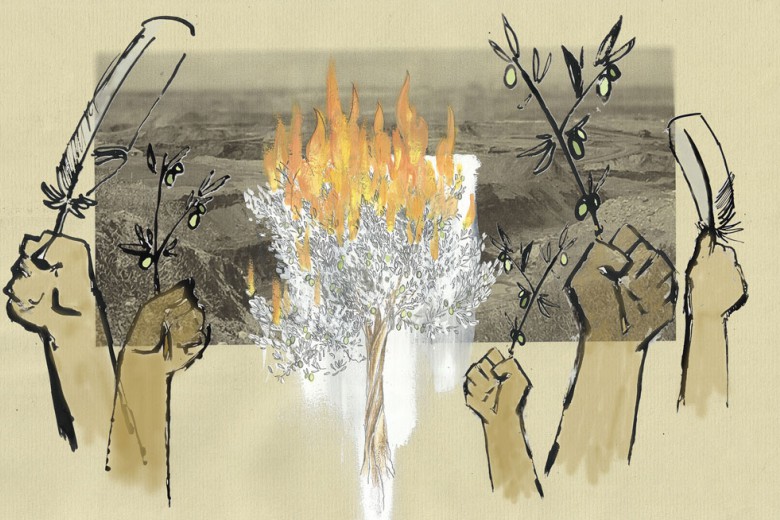
At midnight on May 31, 2009, the guards who manned the Canada Border Services Agency (CBSA) station on the Mohawk (Kahnienkehaka) reserve of Akwesasne, near Cornwall, Ontario, abandoned the Canadian side of the U.S.-Canada border and went home. The guards were to be issued 9-mm Beretta pistols on the following day as part of Canada’s border security policy, but had been warned by Akwesasne community groups that armed agents of the Canadian government would not be tolerated on their land. Despite appeals from the CBSA, Cornwall mayor Bob Kilger and the Mohawk Council of Akwesasne for third party intervention, the federal government ignored the issue and pressed ahead with the policy. The Border Service agents, not wishing to be put in the middle of a major crisis, chose to walk off the job.
A year later, the border station, for all intents and purposes, remains abandoned.
Beneath the Canadian concerns over border security and the community’s fears of irresponsible gun use by border agents lies the far more fundamental question of who has sovereignty over Mohawk territories. “No Guns on Mohawk Land” is a prominent slogan in use by activists and community groups on the Akwesasne territory, reflecting the idea that ultimately Akwesasne, as a community belonging to the Mohawk nation of the Iroquois (Haudenosaunee) Confederacy, is part of a sovereign country that is neither American nor Canadian. Armed agents of these governments on their territory are often regarded as occupational forces. On May 29, 2009, two days before the federal government intended to impose armed border guards on the community, Chief Larry King told the press: “[The Canada Border Service Agency] is a foreign oppressive force who occupies our sovereign community and territory. [They are] unwelcome, uninvited and now carrying firearms. For lack of a different description, that is considered by some an act of war.”
Despite the fact that the Mohawks of Akwesasne consider their community to be one single entity, they are divided nearly down the middle by the border between Canada and the United States, with the Akwesasne reserve on the north side of the border and the St. Regis reservation on the south. The border station, known as the Kawehnoke Port of Entry, lies on this line, and stands as a symbol of intrusion of government authority in the community. When I visited the station last summer, the government signs were covered over with Iroquois Confederacy and Warrior flags.
When the government of Canada informed the community of its intention to arm the border guards in March 2009, the Mohawk Council responded swiftly with a letter to Prime Minister Stephen Harper declaring their opposition to the policy, which they warned would result in a “number of negative consequences,” including “risking irreparable damage” to the Border Services/Mohawk relationship.
The Council expressed concern that arming the border guards would increase the power imbalance in the relationship and result in an increase in human rights violations. According to a study done by Transport Canada in 2002, members of the community constitute 70 per cent of daily traffic across the border. The Mohawks’ primary objection was that Akwesasne is a residential area and armed border services officers would create a menacing environment. But in their statement the Council also pointedly referred to the actions of “your country” – meaning Canada – indicating that while the dispute involved respect of the human rights of Akwesasne community members, it also centred on competing sovereignty claims. The letter cited a resolution passed by the Council that declared that “the Mohawks of Akwesasne have the existing and inherent right of self-determination, which includes the inherent jurisdiction over their lands, peoples and territories.”
The dispute has now dragged on for a year. The Harper government insists it is vital to post armed guards at all entry points across the U.S.-Canada border as part of its post-9/11 enhanced security policy. The border station rests empty but is carefully watched by community members. The bridge that connects the Canadian city of Cornwall to the Akwesasne reserve is tightly controlled by local police, with long waits to enter the reserve and claims of harassment and unjustified vehicle seizures. The federal government claims progress is being made, but on the ground nothing has changed since the dispute began, and one of the few definitive statements made by the government was then-Minister of Public Safety Peter Van Loan’s comment to the press last year: “they’ll have to accept armed border officers there.”
“Ten feet above our heads”
The issue of territorial sovereignty at the heart of the dispute is a sensitive one for both the Mohawks and the government of Canada. Conflicts regarding jurisdiction over territory have sparked numerous crises over the years, sometimes producing violent confrontations. In 1968, the government of Canada provoked major resistance from the Akwesasne community when it attempted to impose duties on goods bought in St. Regis on the American side of the border, despite having no legal basis for doing so. Akwesasne’s resistance to the policy compelled the government to grant duty-free status to the Mohawks by the next year, a concession that put the matter to rest without addressing the issue of the border – did it divide the United States from Canada, or cut the Mohawk nation in half?
From the point of view of the Canadian and American governments, to discuss the issue of territorial sovereignty is absurd: the land is unquestionably Canadian and American on their respective sides of the border by right of treaty and the consent of the Iroquois ancestors. During the Oka Crisis in 1990, then-Prime Minister Brian Mulroney described Mohawk sovereignty claims as “bizarre,” while last year, Prime Minister Harper declared at a G20 press conference that Canadians “have no history of colonialism.” With that one statement Prime Minister Harper rejected most of Canada’s history as a colonial power, as well as most of the Iroquois understanding of their own history.
From the Iroquois point of view, the treaties that form the basis for Canadian and U.S. claims to sovereignty over their territory are perceived as fraudulent, misinterpreted or signed under coercion. According to Sakoietah, a representative of the Akwesasne’s Men’s Traditional Council, in an interview with rabble.ca (June 10, 2009), the historical context of the dispute goes back to the Jay Treaty of 1794, which established the original border between the U.S. and Britain’s remaining North American colonies: “our people perceived that border line as being 10 feet above our heads, it didn’t matter to our people that it was there, this was a line dispute between Britain and the U.S., and this is how they settled that dispute… . That’s the reason our people fight, because we don’t actually believe that there is a border here.”
There is a strong sense in Mohawk communities that the lands of the Confederacy, a vast territory extending from Lake Erie to Montreal and covering parts of Ontario, Quebec and New York state, cannot be ceded by treaty, nor can their sovereignty as a people be revoked. Mohawk activist Jessica Yee argued in an article written days into the border dispute, “we belong to Mother Earth in whom no one has claim over – and where there aren’t any borders.” A representative on behalf of the Iroquois as a self-determining confederacy of peoples, Doug Anderson, delivered a request to the United Nations that UN officials be sent to observe the events at Akwesasne days before the government deadline.
The six nations of the Iroquois Confederacy recognize the Two Row Wampum Treaty (Guswentah) as the basis of the Iroquois/European relationship. The 1613 treaty with the Dutch established nation-to-nation relations, and as a self-determining people they consider it the basis of all their dealings with colonial powers to the present day. The two rows of the wampum belt symbolize the coexistence of the two distinct peoples on one land. Since 1613, there has been no treaty or declaration between a European people and the Iroquois that has changed that relationship.
Neither side appears willing to push these issues to the point of a violent confrontation, but certainly that potential is present. There are ample historical precedents of the potential for conflicts to boil over into crisis and violence. The Warrior Society, a paramilitary organization that historically acted as the defence forces of the Iroquois Confederacy, is mentioned only infrequently in the community’s public statements, but their presence can have an enormous impact on events. In 1974, armed members of the Warrior Society seized territory in New York state at Moss Lake, which they recognized as their traditional land. Naming the land Ganienkeh (“Land of the Flint,” from the Akwesasne name for Mohawk, Kahnienkehake: “People of the Flint”), the Warriors asserted full sovereignty over the territory and forbade non-Natives from setting foot on the land. The reclaiming of Ganienkeh led to a number of incidents in which exchanges of gunfire took place between the Warriors and locals, resulting in a tense standoff with National Guard and New York State Troopers from 1974 until 1977, when the dispute was settled by a concession of a 700-acre territory near the Kahnawake reserve.
The 1990 Oka Crisis in Quebec further emphasized how seriously some Mohawk groups take the battle for Iroquois sovereignty. When members of the Warrior Society occupied sacred ground considered to be part of Kanesatake territory threatened by a golf course expansion, the action was conducted not as a civil protest, but with the military planning and diplomatic protocols of a nationalist revolutionary movement. The 78-day standoff with units of the Quebec provincial police and the Canadian military ended with a moratorium on the development of the land and the arrest of many of the Warriors, but the events at Oka showed how serious many Mohawks are about defending their nationhood, even to the point of revolutionary action and armed resistance.
Despite the relative caution and inactivity of the federal government in the current conflict over the arming of the border guards, the conflict continues to simmer. In March 2010 members of the Akwesasne community brought complaints of harassment and unjustifiable seizures by police on the Cornwall bridge to the Canadian Human Rights Commission, although to no avail. The federal government, for its part, has publicly contemplated moving the border station off the reserve entirely, but has made no decisive statement on the matter.
An atmosphere of siege continues to hang over Akwesasne.






